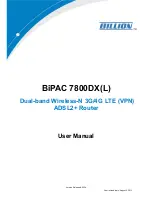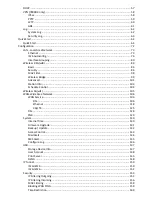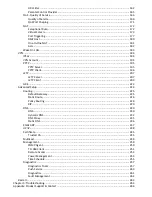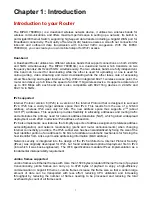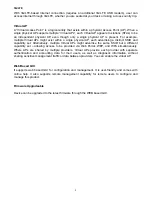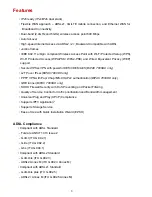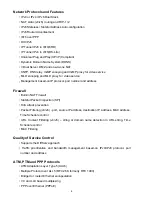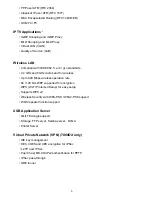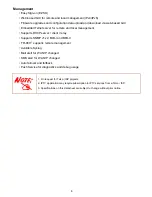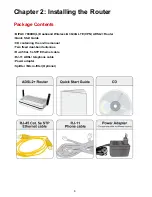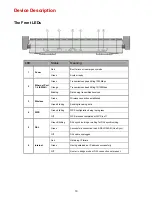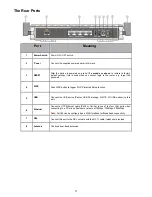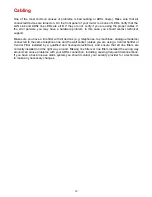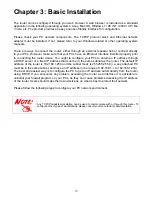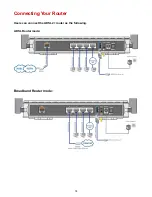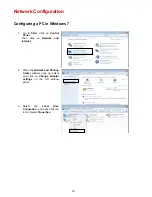
1
Chapter 1: Introduction
Introduction to your Router
The BiPAC 7800DX(L) is a dual-band wireless network device, it utilizes two wireless bands for
wireless communications, and offers maximum performance in setting up a network. Its built-in 4-
port Gigabit Ethernet Switch, supporting high-speed data transfer including a Gigabit WAN port for
Broadband connectivity. The Quality of Service (QoS) feature ensures a smooth net connection for
inbound and outbound data transmission with minimal traffic congestion. With the BiPAC
7800DX(L), you can create your own mobile hotspot for Wi-Fi access.
Dual-band
A Dual-band Router utilizes two different wireless bands that support connections on both 2.4GHz
and 5GHz simultaneously. The BiPAC 7800DX(L) is a dual-band router which transmits on two
frequency bands-2.4GHz and 5GHz simultaneously. The two wireless bands are fully independent.
One band can be used for downloading while the other is used for uploading; or one is used for
online gaming, video streaming and music downloading while the other takes care of accessing
email, file sharing and regular internet surfing. With an integrated 802.11 wireless access point, the
router can deliver up to 6 times the speed of an 802.11b/g wireless device. It supports a date rate of
up to 300 Mbps with each band and is also compatible with 802.11b/g devices in 2.4GHz and
802.11a in 5GHz.
IPv6 supported
Internet Protocol version 6 (IPv6) is a version of the Internet Protocol that is designed to succeed
IPv4. IPv6 has a vastly larger address space than IPv4. This results from the use of a 128-bit
address, whereas IPv4 uses only 32 bits. The new address space thus supports 2
128
(about
3.4×10
38
) addresses. This expansion provides flexibility in allocating addresses and routing traffic
and eliminates the primary need for network address translation (NAT), which gained widespread
deployment as an effort to alleviate IPv4 address exhaustion.
IPv6 also implements new features that simplify aspects of address assignment (stateless address
autoconfiguration) and network renumbering (prefix and router announcements) when changing
Internet connectivity providers. The IPv6 subnet size has been standardized by fixing the size of the
host identifier portion of an address to 64 bits to facilitate an automatic mechanism for forming the
host identifier from Link Layer media addressing information (MAC address).
Network security is integrated into the design of the IPv6 architecture. Internet Protocol Security
(IPsec) was originally developed for IPv6, but found widespread optional deployment first in IPv4
(into which it was back-engineered). The IPv6 specifications mandate IPsec implementation as a
fundamental interoperability requirement.
Jumbo frames supported
Jumbo frames are Ethernet frames with more than 1500 bytes (standard Ethernet frame) of payload.
Conventionally, jumbo frames can carry up to 9720 bytes of payload to enjoy a high-efficiency
communication in Gigabit Ethernet. Jumbo frames increase the frame size so that a certain large
amount of date can be transported with less effort, reducing CPU utilization and increasing
throughput by reducing the number of frames needing to be processed and reducing the total
overhead byte count of all frames sent.
Summary of Contents for 7800DX
Page 19: ...15 3G LTE Router mode ...
Page 37: ...33 Click link 192 168 1 254 it will lead you to the following page ...
Page 40: ...36 Click 192 168 1 254 it will lead you to the following page ...
Page 43: ...39 Click 192 168 1 254 it will lead you to the following page ...
Page 99: ...95 Configure AP as Enrollee Add Registrar with PIN Method 1 Set AP to Unconfigured Mode ...
Page 143: ...139 Accessing mechanism of Storage In your computer Click Start Run enter 192 168 1 254 ...
Page 145: ...141 Access the folder public ...
Page 148: ...144 Step 2 Click Add a Printer Step 3 Click Add a network wireless or Bluetooth printer ...
Page 159: ...155 Rule inactive ...
Page 186: ...182 ALG The ALG Controls enable or disable protocols over application layer ...
Page 194: ...190 ...
Page 197: ...193 ...
Page 204: ...200 5 Input the account user name and password and press Create ...
Page 205: ...201 6 Connect to the server ...
Page 206: ...202 7 Successfully connected ...
Page 208: ...204 ...
Page 219: ...215 4 Input Internet address and Destination name for this connection and press Next ...
Page 220: ...216 5 Input the account user name and password and press Create ...
Page 238: ...234 2 ipoe_eth0 with DDNS www hometest1 com using username password test test ...
Page 251: ...247 Click Apply to confirm your settings ...
Page 262: ...258 Example Ping www google com ...
Page 263: ...259 Example trace www google com ...

